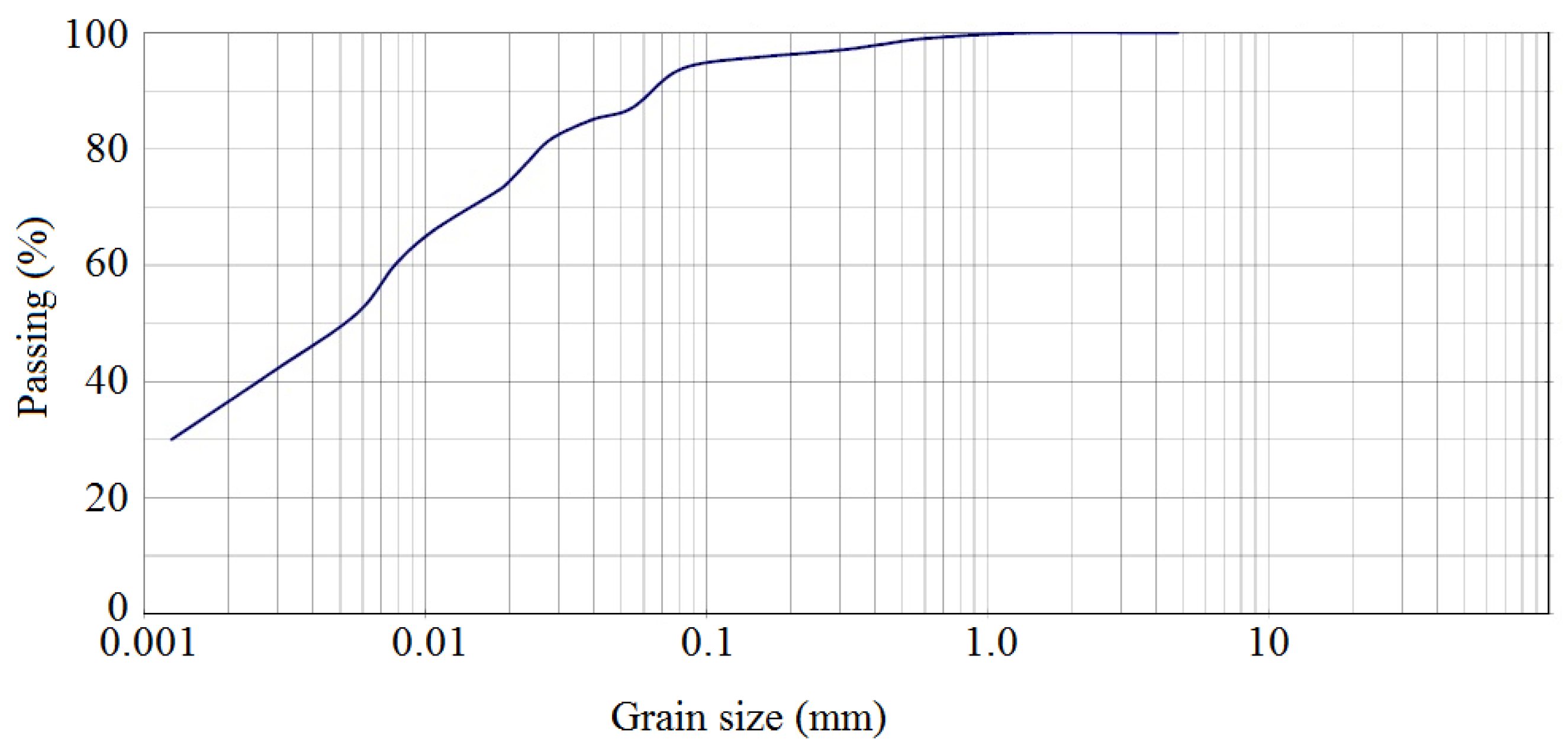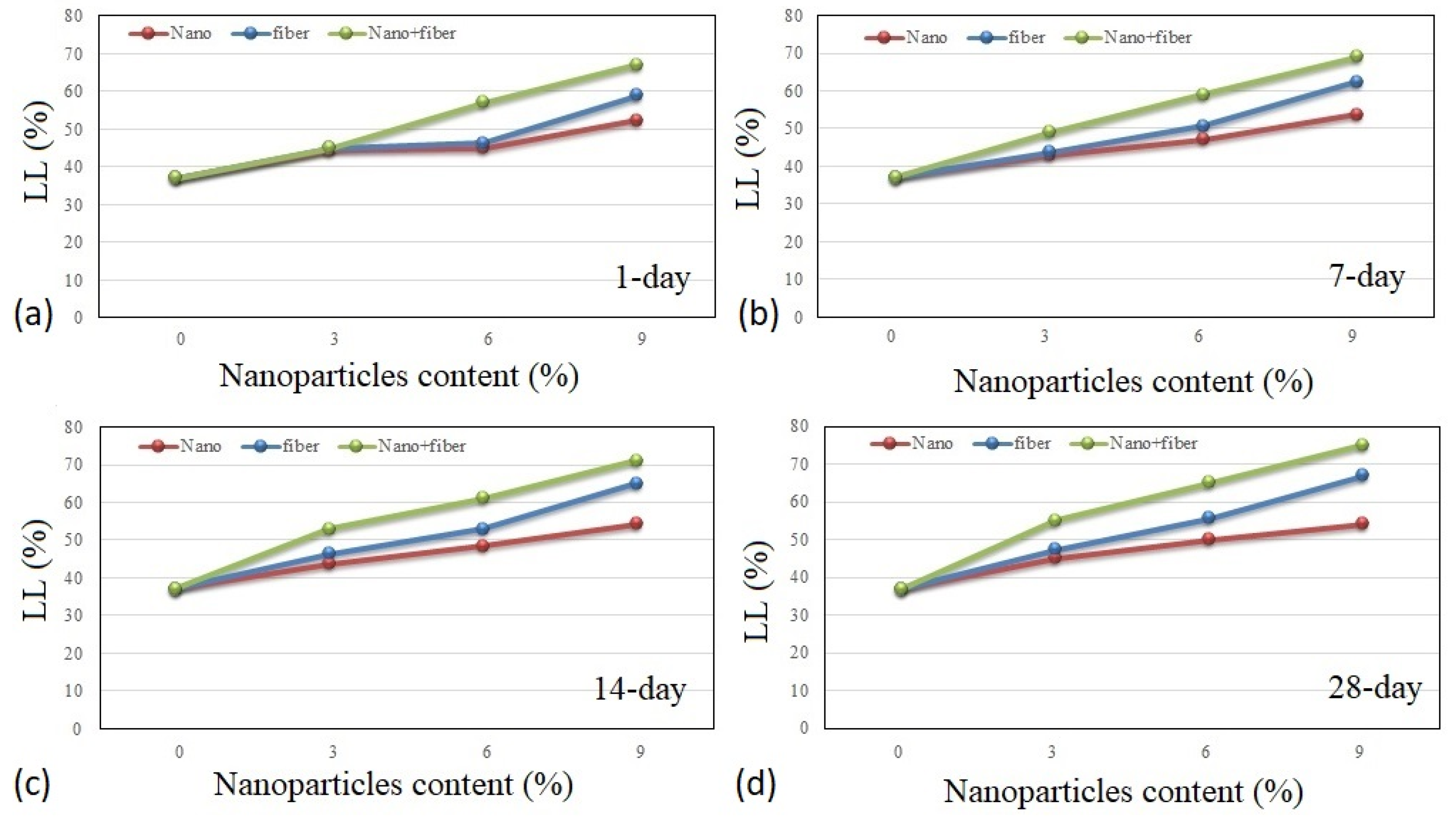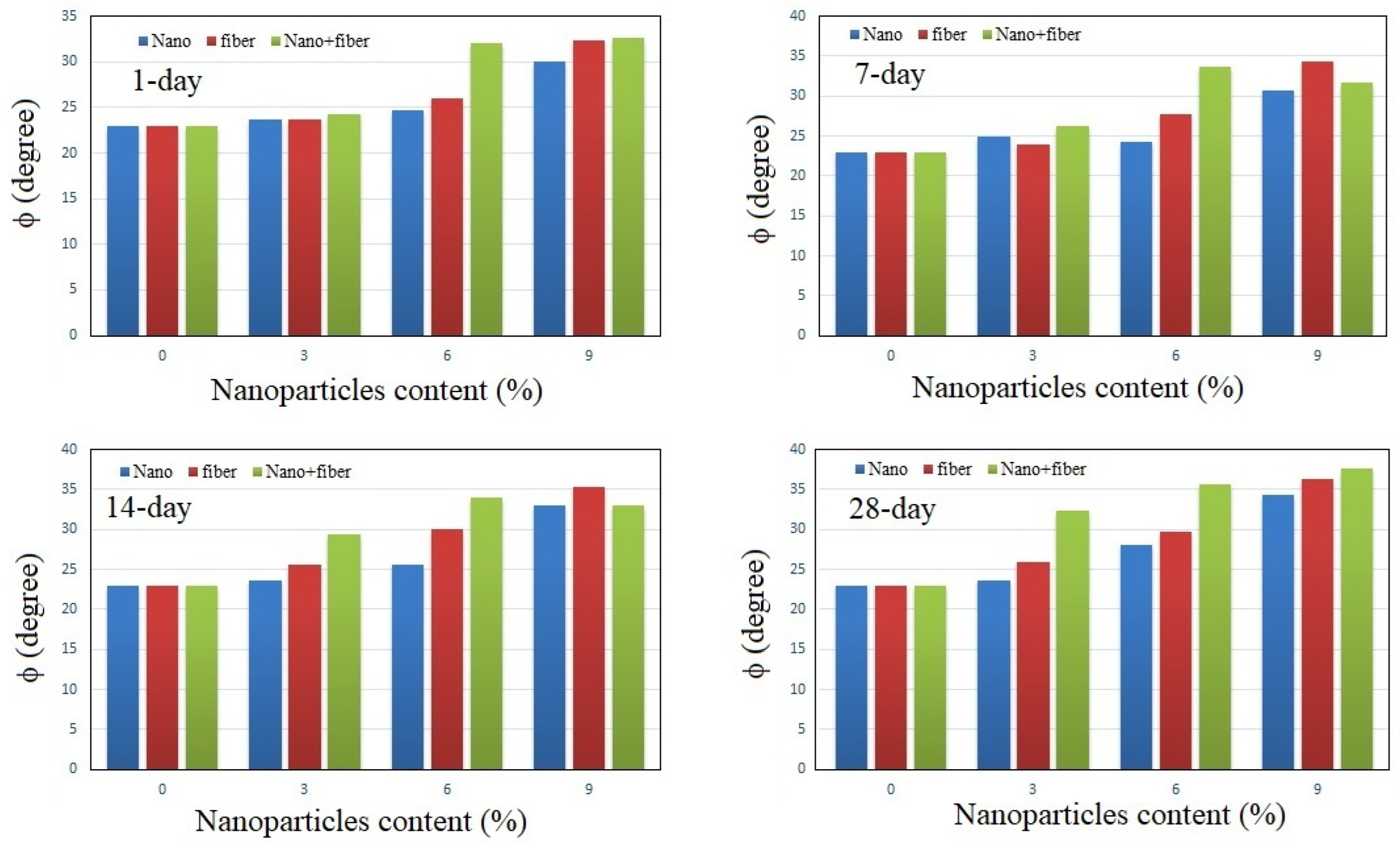Investigation of the Leachate Effect on Permeability and Geotechnical Characteristics of Fine-Grained Soil Modified Using Nanoclay–Nanofiber Composites
Abstract
:1. Introduction
2. Materials and Methods
2.1. Landfill Leachate
2.2. Experimental Procedures
2.3. Nanoparticles Specifications
2.4. Permeability Analysis
2.5. Geotechnical Investigations
3. Results and Discussion
4. Conclusions
- The studied soil is classified as CL class based on USCS which is estimated using particle size and hydrometry tests. CL stands for clayey soil with low plasticity.
- Regarding permeability tests, the results indicated that additives such as nanoclay, nanofiber, and nanocomposite (nanoclay–nanofiber) reduce permeability. Nanoclay reduces the permeability from 4.25 × 10−6 cm/s to 5.25 × 10−8 cm/s. Nanofiber reduces the main value to 3.24 × 10−8 cm/s and nanocomposite reduces it to 6.34 × 10−9 cm/s. Therefore, this estimation application of nanoclay–nanofiber composite shows significant work on permeability reduction.
- Measured Atterberg limits for different groups showed that the plasticity increased with an increasing in the nanoparticle additives, but it increased more rapidly for LL than PI or PL. Nanoclays were recognized as responsible for the plastic behavior of the soil.
- UCS and c increase when increasing the type and amount of additives in soil, while φ has not shown the significant action of variations. Results show that the nanoclay–nanofiber composite has provided good improvements in soil durability, with increased UCS from 120 kPa to 220 kPa after a 28-day waiting period. It increased c from 185 kPa to 288 kPa as well.
- Considering the results of the study it appeared that the nanoclay–nanofiber composite had a good impact on leachate control by reducing permeability and increasing soil durability and mechanical properties which can now be attributed to the optimal design of the landfill liners.
Author Contributions
Funding
Data Availability Statement
Conflicts of Interest
References
- McBean, E.A.; Rovers, F.A.; Farquhar, G.J. Solid Waste Landfill Engineering and Design; Prentice Hall: Hoboken, NJ, USA, 1994. [Google Scholar]
- Luo, H.; Zeng, Y.; Cheng, Y.; He, D.; Pan, X. Recent advances in municipal landfill leachate: A review focusing on its characteristics, treatment, and toxicity assessment. Sci. Total Environ. 2020, 703, 135468. [Google Scholar] [CrossRef] [PubMed]
- Das, S.; Lee, S.H.; Kumar, P.; Kim, K.H.; Lee, S.S.; Bhattacharya, S.S. Solid waste management: Scope and the challenge of sustainability. J. Clean. Prod. 2019, 228, 658–678. [Google Scholar] [CrossRef]
- Costa, A.M.; Alfaia, R.G.D.S.M.; Campos, J.C. Landfill leachate treatment in Brazil—An overview. J. Environ. Manag. 2019, 232, 110–116. [Google Scholar] [CrossRef] [PubMed]
- Nanda, S.; Berruti, F. Municipal solid waste management and landfilling technologies: A review. Environ. Chem. Let. 2021, 19, 1433–1456. [Google Scholar] [CrossRef]
- Azizpour, A.; Azarafza, M.; Akgün, H. The impact of municipal waste disposal of heavy metals on environmental pollution: A case study for Tonekabon, Iran. Adv. Environ. Res. 2020, 9, 175–189. [Google Scholar]
- Azarafza, M.; Asghari-Kaljahi, E.; Moshrefy-far, M.R. Effects of clay nanoparticles added to the bonab landfill soil to reduce the permeability and control of leachate. Iran. J. Environ. Geol. 2015, 8, 7–17. (In Persian) [Google Scholar]
- Teng, C.; Zhou, K.; Peng, C.; Chen, W. Characterization and treatment of landfill leachate: A review. Water Res. 2021, 203, 117525. [Google Scholar] [CrossRef]
- Vesilind, P.A.; Worrell, W.A.; Reinhart, D.R. Solid Waste Engineering; Brooks/Cole-Thomson Learning: Pacific Grove, CA, USA, 2002. [Google Scholar]
- Pazoki, M.; Ghasemzadeh, R. Municipal Landfill Leachate Management (Environmental Science and Engineering); Springer: Berlin/Heidelberg, Germany, 2020. [Google Scholar]
- Baysal, G.; Aydın, H.; Uzan, S.; Hoşgören, H. Investigation of Antimicrobial Properties of QASs+ (Novel Synthesis). Russ. J. Phys. Chem. B 2018, 12, 695–700. [Google Scholar] [CrossRef]
- Abbasi, N.; Farjad, A.; Sepehri, S. The use of nanoclay particles for stabilization of dispersive clayey soils. Geotech. Geol. Eng. 2017, 35, 327–335. [Google Scholar] [CrossRef]
- Nikbakht, M.; Sarand, F.B.; Dabiri, R.; Bonab, M.H. Application of nanoclay and nanofiber filters to reduce soil permeability and leachates from landfill liners: A Review. J. Geotech. Geol. 2022, 18, 671–680. [Google Scholar]
- Darnhorng, H.; Hsieh, C. Improving Mudstone Materials in Badland in Southwestern Taiwan by Increasing Density and Low-Cement Amount. Appl. Sci. 2022, 12, 2290. [Google Scholar]
- Lin, D.F.; Luo, H.L.; Hsiao, D.H.; Chen, C.T. Enhancing soft subgrade soil with a sewage sludge ash/cement mixture and nanosilicon dioxide. Environ. Earth Sci. 2016, 75, 619. [Google Scholar] [CrossRef]
- Daniel, D.E.; Benson, C.H. Water content-density criteria for compacted soil liners. J. Geotech. Eng. ASCE 1990, 11612, 1811–1830. [Google Scholar] [CrossRef]
- Sheu, C.; Lin, T.T.; Chang, J.E.; Cheng, C.H. The feasibility of mudstone material as a natural landfill liner. J. Hazard. Mater. 1998, 58, 237–247. [Google Scholar] [CrossRef]
- Herrmann, I.; Svensson, M.; Ecke, H.; Kumpiene, J.; Maurice, C. Hydraulic Conductivity of Fly Ash–Sewage Sludge Mixes for Use in Landfill Cover Liners. J. Water Res. 2009, 43, 3541–3547. [Google Scholar] [CrossRef] [PubMed]
- Kananizadeh, N.; Ebadi, T.; Khoshniat, S.A.; Mousavirizi, S.E. The positive effects of nanoclay on the hydraulic conductivity of compacted Kahrizak clay permeated with landfill leachate. Clean Soil Air Water 2011, 39, 605–611. [Google Scholar] [CrossRef]
- Debnath, S.; Nguong, C.W.; Lee, S.N.B. A review on natural fibre reinforced polymer composites. World Acad. Sci. Eng. Technol. 2013, 7, 1123–1130. [Google Scholar]
- Li, J.S.; Xue, Q.; Wang, P.; Liu, L. Influence of leachate pollution on machanichal properties of compact clay: A case study on behaviors and machanisms. Eng. Geol. 2013, 167, 128–133. [Google Scholar] [CrossRef]
- Bahari, M.; Emadi, A.R.; Shahnazari, A. Experimental and Numerical Study of Adding Nanoclay on Reducing Seepage loss of Ab-Bandan. J. Irrig. Water Eng. 2016, 6, 62–75. [Google Scholar]
- Jafari, B.; Abbasian, K. Experimental study of the nanoclays effects on soil permeability reduction to preparing Landfill liners vs leachate. J. Geotech. Geol. 2018, 14, 217–221. [Google Scholar]
- Jafari, B.; Abbasian, K. Application of nanoclay filter to permeability reduction for bed soil from industrial effluent transmission channels (Case Study). J. Geotech. Geol. 2019, 15, 267–271. [Google Scholar]
- Derakhshani, E.; Naghizadeh, A. Optimization of humic acid removal by adsorption on to bentonite and montmorillonite nanoparticles. J. Mol. Liq. 2018, 259, 76–81. [Google Scholar] [CrossRef]
- Almasri, D.A.; Rhadfi, T.; Atieh, M.A.; McKay, G.; Ahzi, S. High performance hydroxyiron modified montmorillonite nanoclay adsorbent for arsenite removal. Chem. Eng. J. 2018, 335, 1–12. [Google Scholar] [CrossRef]
- Dlamini, D.S.; Li, J.; Mamba, B.B. Critical review of montmorillonite/polymer mixed-matrix filtration membranes: Possibilities and challenges. Appl. Clay Sci. 2019, 168, 21–30. [Google Scholar] [CrossRef]
- Qasaimeh, A.; Sharo, A.A.; Bani-Melhem, K. Clayey Soil Amendment by Hydrophilic Nano Bentonite for Landfill Cover Barrier: A Case Study. J. Environ. Eng. Landsc. Manag. 2020, 28, 148–156. [Google Scholar] [CrossRef]
- Mehrabi, P.; Shariati, M.; Kabirifar, K.; Jarrah, M.; Rasekh, H.; Trung, N.T.; Shariati, A.; Jahandari, S. Effect of pumice powder and nanoclay on the strength and permeability of fiber-reinforced pervious concrete incorporating recycled concrete aggregate. Construct. Build. Mater. 2021, 287, 122652. [Google Scholar] [CrossRef]
- ASTM D4972; Standard Test Methods for pH of Soils. ASTM International: West Conshohocken, PA, USA, 2019.
- Morrison, G. Landfill Leachate: Control, Treatment and Environmental Impact; Nova Science Publishers: New York, NY, USA, 2019. [Google Scholar]
- Kurniawan, T.A. Landfill Leachate Treatment: Laboratory Studies: Removal of Refractory Pollutants from Landfill Leachate Using Advanced Oxidation Process and Activated Carbon Adsorption; LAP LAMBERT Academic Publishing: Saarland, Germany, 2012. [Google Scholar]
- Holtz, D.R.; Kovacs, D.W. Introduction to Geotechnical Engineering, 2nd ed.; Pearson: Strand, London, UK, 2010. [Google Scholar]
- ASTM D1140; Standard Test Methods for Amount of Material in Soil Finer than No. 200 (75 micrometer) Sieve. ASTM International: West Conshohocken, PA, USA, 2017.
- ASTM D422; Standard Test Methods for Particle Size Analysis of Soils. ASTM International: West Conshohocken, PA, USA, 2006.
- ASTM D4318; Standard Test Methods for Liquid Limit, Plastic Limit, and Plasticity Index of Soils. ASTM International: West Conshohocken, PA, USA, 2005.
- ASTM D2434; Standard Test Methods for Measurement of Hydraulic Conductivity of Coarse-Grained Soils. ASTM International: West Conshohocken, PA, USA, 2020.
- ASTM D2166; Standard Test Method for Unconfined Compressive Strength of Cohesive Soil. ASTM International: West Conshohocken, PA, USA, 2016.
- ASTM D3080; Standard Test Method for Direct Shear Test of Soils Under Consolidated Drained Conditions. ASTM International: West Conshohocken, PA, USA, 2004.
- Nikbakht, M.; Sarand, F.B.; Esmatkhah Irani, A.; Hajialilue Bonab, M.; Azarafza, M.; Derakhshani, R. An Experimental Study for Swelling Effect on Repairing of Cracks in Fine-Grained Clayey Soils. Appl. Sci. 2022, 12, 8596. [Google Scholar] [CrossRef]











| Samples | 1 | 2 | 3 | 4 | 5 | 6 | 7 | 8 | 9 |
|---|---|---|---|---|---|---|---|---|---|
| pH | 7.22 | 7.13 | 7.20 | 7.22 | 7.17 | 7.22 | 7.13 | 7.13 | 7.13 |
| T (°C) | 118.1 | 17.7 | 18.3 | 18.0 | 17.2 | 17.8 | 17.7 | 18.1 | 18.3 |
| TDS (ppm) | 496.12 | 498.33 | 492.25 | 489.36 | 496.11 | 490.45 | 486.70 | 450.12 | 476.42 |
| As (pmm) | 12.2 | 7.3 | 9.9 | 5.7 | 9.6 | 6.3 | 10.7 | 9.6 | 12.2 |
| Cd (ppm) | 1.10 | 1.14 | 1.06 | 1.03 | 0.98 | 1.17 | 1.02 | 0.97 | 0.97 |
| Co (ppm) | 47.6 | 45.4 | 47.3 | 45.6 | 47.3 | 45.5 | 47.3 | 47.3 | 45.6 |
| Cr (ppm) | 63.14 | 71.1 | 75.63 | 79.64 | 63.35 | 17.17 | 66.38 | 65.97 | 71.49 |
| Cu (ppm) | 96.83 | 96.85 | 97.10 | 96.37 | 97.45 | 96.17 | 96.75 | 97.58 | 96.19 |
| Mn (ppm) | 91.3 | 102.7 | 95.5 | 97.3 | 95.6 | 91.3 | 91.7 | 95.5 | 97.3 |
| Ni (ppm) | 87.30 | 87.42 | 85.96 | 87.74 | 87.35 | 86.91 | 87.50 | 87.63 | 87.33 |
| Pb (ppm) | 192.1 | 189.7 | 196.3 | 190.0 | 196.4 | 196.4 | 192.5 | 231.9 | 238.0 |
| Zn (ppm) | 234.7 | 248.2 | 239.7 | 237.0 | 237.0 | 235.4 | 239.1 | 231.9 | 238.0 |
| Hg (ppm) | 7.47 | 6.03 | 7.17 | 7.41 | 7.10 | 6.65 | 6.85 | 7.10 | 6.36 |
| Ca (ppm) | 65.71 | 67.77 | 65.63 | 97.12 | 65.45 | 97.36 | 65.22 | 67.47 | 65.60 |
| Na (ppm) | 15.9 | 12.5 | 15.4 | 14.9 | 15.2 | 12.9 | 17.2 | 14.9 | 12.5 |
| Mg (ppm) | 15.23 | 15.03 | 14.56 | 17.73 | 14.81 | 15.20 | 14.65 | 17.71 | 15.02 |
| HCO3− (ppm) | 25.41 | 27.33 | 25.45 | 27.12 | 25.63 | 27.92 | 25.40 | 25.45 | 27.12 |
| Cl− (ppm) | 6.39 | 6.35 | 7.10 | 6.89 | 6.33 | 7.17 | 6.63 | 7.25 | 6.32 |
| NO3− (ppm) | 17.20 | 16.96 | 17.15 | 17.12 | 16.85 | 17.20 | 16.74 | 15.56 | 17.31 |
| SO42− (ppm) | 18.85 | 18.63 | 18.74 | 18.52 | 18.25 | 19.12 | 18.78 | 18.45 | 19.02 |
| Parameter | Unit | Value |
|---|---|---|
| Physical properties | ||
| Clay type | - | Montmorillonite |
| Particle size | mn | 1–2 |
| Density | g/cm3 | 0.5–0.7 |
| Specific surface area | m2/g | 220–270 |
| Electrical resistivity | MV | −25 |
| Inter-particles distance | A° | 60 |
| Ion exchange coefficient | meg/100 g | 48 |
| Color | - | Pale yellow |
| Moisture | % | 1–2 |
| Chemical properties | ||
| Na2O | % | 0.98 |
| MgO | % | 3.29 |
| Al2O3 | % | 19.60 |
| SiO2 | % | 50.95 |
| K2O | % | 0.68 |
| CaO | % | 1.97 |
| TiO2 | % | 0.62 |
| Fe2O3 | % | 5.62 |
| LOI | % | 15.45 |
| Parameter | Unit | Value |
|---|---|---|
| Fiber type | - | Carbon nanofiber |
| Solids | w% | Aqueous gel (3.0) + dry powder (98) |
| Fiber dimensions | nm | 50 |
| Surface property | m2/g (BET) | 31–33 (Hydrophilic) |
| Density | g/cm3 | Aqueous gel (1.0) + dry powder (1.5) |
| Fiber length | A° | 4.5 |
| Specific surface area | m2/g | 149.5 |
| Electrical resistivity | MV | −253 |
| Color | - | Pale yellow |
| Moisture | % | 1 |
| Yield of fibrillation | % | 91.25 |
| Transmittance at 600 nm | % | 65 |
| Water Retention | g/g | 4.8 |
Disclaimer/Publisher’s Note: The statements, opinions and data contained in all publications are solely those of the individual author(s) and contributor(s) and not of MDPI and/or the editor(s). MDPI and/or the editor(s) disclaim responsibility for any injury to people or property resulting from any ideas, methods, instructions or products referred to in the content. |
© 2023 by the authors. Licensee MDPI, Basel, Switzerland. This article is an open access article distributed under the terms and conditions of the Creative Commons Attribution (CC BY) license (https://creativecommons.org/licenses/by/4.0/).
Share and Cite
Nikbakht, M.; Sarand, F.B.; Dabiri, R.; Hajialilue Bonab, M. Investigation of the Leachate Effect on Permeability and Geotechnical Characteristics of Fine-Grained Soil Modified Using Nanoclay–Nanofiber Composites. Water 2023, 15, 294. https://doi.org/10.3390/w15020294
Nikbakht M, Sarand FB, Dabiri R, Hajialilue Bonab M. Investigation of the Leachate Effect on Permeability and Geotechnical Characteristics of Fine-Grained Soil Modified Using Nanoclay–Nanofiber Composites. Water. 2023; 15(2):294. https://doi.org/10.3390/w15020294
Chicago/Turabian StyleNikbakht, Mehdi, Fariba Behrooz Sarand, Rouzbeh Dabiri, and Masoud Hajialilue Bonab. 2023. "Investigation of the Leachate Effect on Permeability and Geotechnical Characteristics of Fine-Grained Soil Modified Using Nanoclay–Nanofiber Composites" Water 15, no. 2: 294. https://doi.org/10.3390/w15020294






